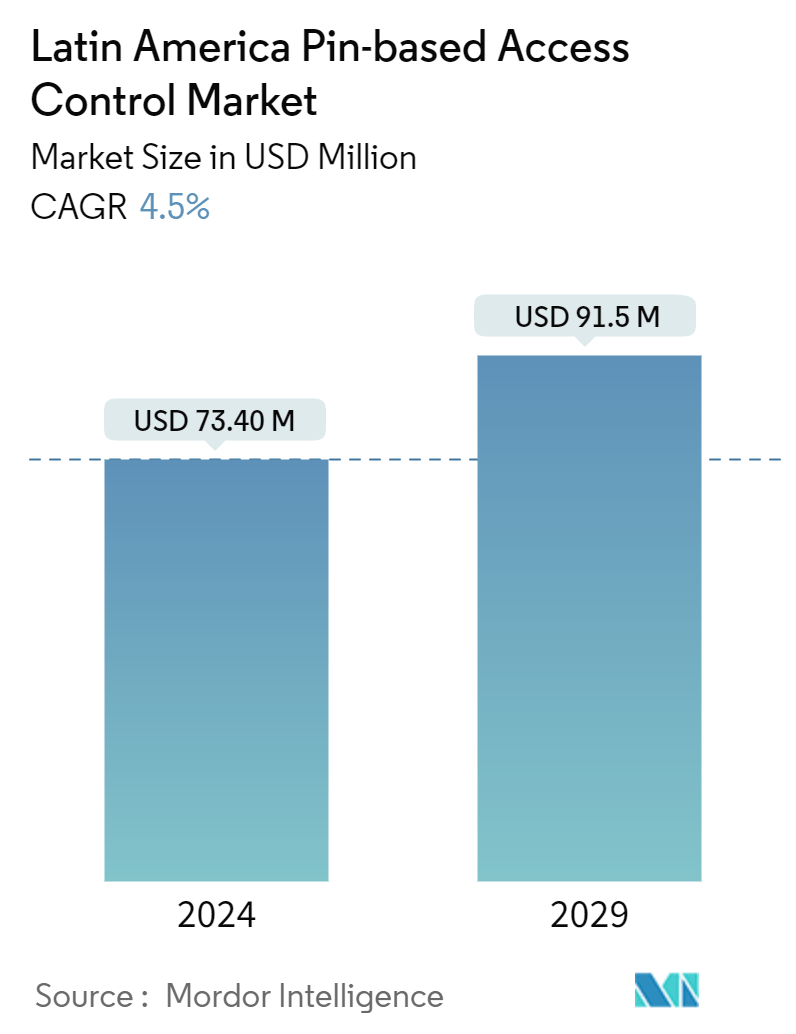Market Size of Latin America Pin-based Access Control Industry

| Study Period | 2019 - 2029 |
| Base Year For Estimation | 2023 |
| Market Size (2024) | USD 73.40 Million |
| Market Size (2029) | USD 91.5 Million |
| CAGR (2024 - 2029) | 4.50 % |
| Market Concentration | Low |
Major Players
*Disclaimer: Major Players sorted in no particular order |
Latin America Pin-based Access Control Market Analysis
The Latin America Pin-based Access Control Market size is estimated at USD 73.40 million in 2024, and is expected to reach USD 91.5 million by 2029, growing at a CAGR of 4.5% during the forecast period (2024-2029).
- Rising concerns over privacy and security, coupled with a surge in data theft, are key drivers propelling market growth. In recent years, Latin America has witnessed a surge in thefts and crime rates, raising significant concerns about the safety of individuals, assets, and operations. These trends have not only led to substantial infrastructure damage but also tragically claimed numerous lives. Access control systems play a significant role in modern security measures. These systems bolster property security and streamline entry for authorized personnel while effectively blocking unauthorized access.
- Furthermore, pin-based access controls are easily scalable, which makes them suitable for SMEs who want to secure their data without having to spend extra money. Several organizations are upgrading to pin-based attendance systems to minimize the efforts, as the traditional method of keeping track of time and attendance resulted in expensive mistakes and aggravating inefficiencies because employees had to fill out paper timesheets to track their working hours.
- In 2023, as reported by Brazil's Ministry of Defense, Sao Paulo, the city in Brazil witnessed over half a million theft cases, excluding vehicle theft, marking it as the most prevalent crime. Following closely, robberies accounted for nearly 222,000 incidents, making it the second most common offense. Moreover, as per the 2023 Brazilian Public Security Yearbook, certain states in Brazil exhibit elevated rates of vehicle robbery and theft. Rio de Janeiro, reporting 562 incidents per 100,000 vehicles in 2022, is topping this list. Following closely is Pernambuco, situated in the Northeast, with 534 cases per 100,000 vehicles. Such activities create a huge demand for access control solutions.
- Despite a projected contraction in 2025, the Mexican construction industry is set to rebound. This dip is largely attributed to high base effects and the culmination of significant infrastructure projects. In a proactive move, in November 2023, the Mexican government issued a decree focused on bolstering the nation's rail infrastructure. Simultaneously, they rolled out a recovery initiative, allocating a substantial MXN 69.9 billion (USD 3.4 billion) for revitalizing key infrastructure in Acapulco. Furthermore, as part of the 2024 Federal Budget Proposal, the government earmarked a net spending of MXN 9.1 trillion (USD 441.1 billion), marking a 4.3% increase from the 2023 budget. The increasing construction across the countries will propel the market growth in the coming years.
- Additionally, biometrics authentication is rapidly increasing across various industries by providing more secure identity verification processes. This technology uses physical characteristics like facial recognition, fingerprint scan, voice recognition, and retina recognition to authenticate the user. The necessity for strict identity verification due to the accelerating adoption of transactional technologies is increasing the demand for biometrics access controls, which consumers prefer over traditional pin-based access control, hindering market growth.
- The growing inflation rates have increased the cost of goods and services, including access control systems. Higher costs lead to reduced purchasing power for consumers and businesses, slowing market growth. Further, the ongoing war between Russia and Ukraine has disrupted the global supply chain, particularly affecting the availability and cost of electronic components and raw materials used in access control systems. This is leading to delays in production and increased costs for manufacturers.
Latin America Pin-based Access Control Industry Segmentation
Access control systems are an essential element of security that governs who is allowed access to specific information, applications, and data sources. It safeguards sensitive information, such as information of customers and intellectual property, from being stolen by malicious actors or unauthorized users. Pin-based access control is a popular method of authenticating consumer identity more efficiently.
The study tracks the revenue accrued through the sale of pin-based access control systems by various players in Latin America. The study also tracks the key market parameters, underlying growth influencers, and major vendors operating in the industry, which supports the market estimations and growth rates over the forecast period. The study further analyses the overall impact of COVID-19 aftereffects and other macroeconomic factors on the market. The report’s scope encompasses market sizing and forecasts for the various market segments.
The Latin America pin-based access control market is segmented by component (hardware, software), by organization size (SMEs, large enterprises), by end-user industry (banking and financial services, government services, retail, IT and telecommunications, healthcare, power and utilities, residential, and others), by country (Brazil, Mexico, Argentina, Rest of Latin America). The market sizes and forecasts are provided in terms of value (USD) for all the above segments.
| by Component | |
| Hardware | |
| Software |
| By Organization Size | |
| SMEs | |
| Large Enterprises |
| By End-user Industry | |
| Banking and Financial Services | |
| Government Services | |
| Retail | |
| IT and Telecommunications | |
| Healthcare | |
| Power and Utilities | |
| Residential | |
| Other End-user Industries |
| By Country*** | |
| Brazil | |
| Mexico | |
| Argentina |
Latin America Pin-based Access Control Market Size Summary
The Latin America pin-based access control market is experiencing growth driven by increasing concerns over privacy and security, alongside a rise in data theft incidents. The region has seen a notable increase in crime rates, particularly thefts and robberies, which have heightened the demand for robust access control systems. These systems are essential for enhancing property security and managing access for authorized personnel, thereby preventing unauthorized entry. The scalability of pin-based access controls makes them particularly appealing to small and medium-sized enterprises (SMEs) looking to secure their data cost-effectively. Additionally, the shift from traditional attendance tracking methods to pin-based systems is helping organizations reduce inefficiencies and errors associated with manual processes. The market is further supported by the ongoing urbanization and technological advancements in the region, which are driving the need for secure access solutions in both residential and commercial sectors.
Despite challenges such as rising inflation and global supply chain disruptions affecting the cost and availability of electronic components, the market for pin-based access control systems is poised for growth. The increasing adoption of smartphones and mobile computing devices is expected to boost the demand for integrated access control solutions. Moreover, the financial sector's focus on enhancing security through multi-factor authentication is contributing to the market's expansion. The market is characterized by fragmentation, with several key players actively seeking to enhance their presence through product innovations and strategic partnerships. Recent developments, such as the introduction of advanced access control solutions and strategic acquisitions, underscore the dynamic nature of the market and its potential for continued growth in the coming years.
Latin America Pin-based Access Control Market Size - Table of Contents
-
1. MARKET INSIGHTS
-
1.1 Market Overview
-
1.2 Industry Attractiveness - Porter's Five Forces Analysis
-
1.2.1 Bargaining Power of Suppliers
-
1.2.2 Bargaining Power of Consumers
-
1.2.3 Threat of New Entrants
-
1.2.4 Threat of Substitutes
-
1.2.5 Intensity of Competitive Rivalry
-
-
1.3 Impact of COVID-19 Aftereffects and Other Macroeconomic Factors on the Market
-
-
2. MARKET SEGMENTATION
-
2.1 by Component
-
2.1.1 Hardware
-
2.1.2 Software
-
-
2.2 By Organization Size
-
2.2.1 SMEs
-
2.2.2 Large Enterprises
-
-
2.3 By End-user Industry
-
2.3.1 Banking and Financial Services
-
2.3.2 Government Services
-
2.3.3 Retail
-
2.3.4 IT and Telecommunications
-
2.3.5 Healthcare
-
2.3.6 Power and Utilities
-
2.3.7 Residential
-
2.3.8 Other End-user Industries
-
-
2.4 By Country***
-
2.4.1 Brazil
-
2.4.2 Mexico
-
2.4.3 Argentina
-
-
Latin America Pin-based Access Control Market Size FAQs
How big is the Latin America Pin-based Access Control Market?
The Latin America Pin-based Access Control Market size is expected to reach USD 73.40 million in 2024 and grow at a CAGR of 4.5% to reach USD 91.5 million by 2029.
What is the current Latin America Pin-based Access Control Market size?
In 2024, the Latin America Pin-based Access Control Market size is expected to reach USD 73.40 million.

